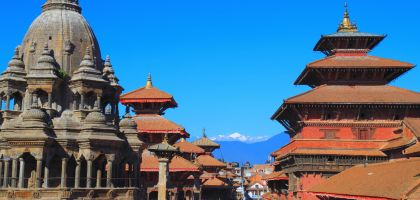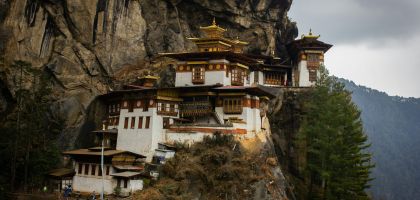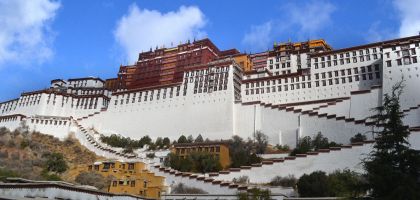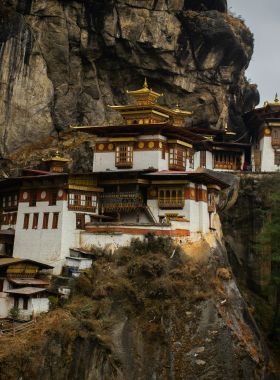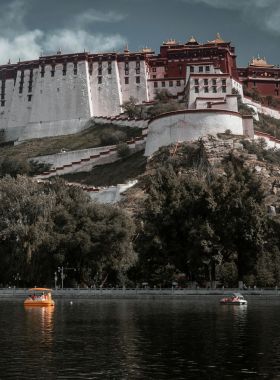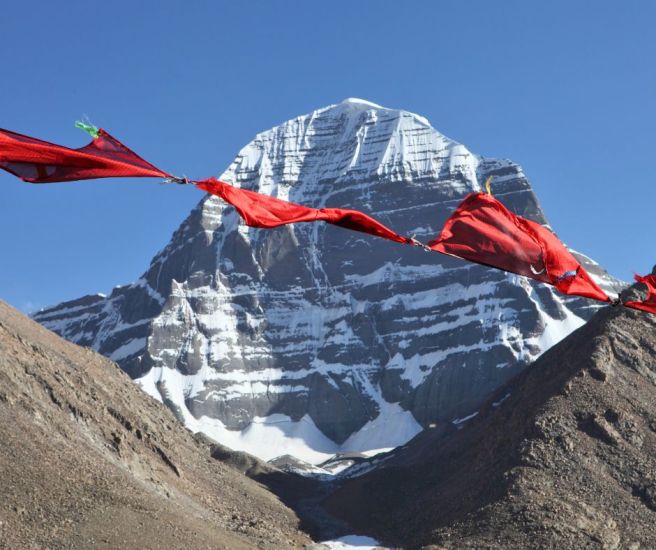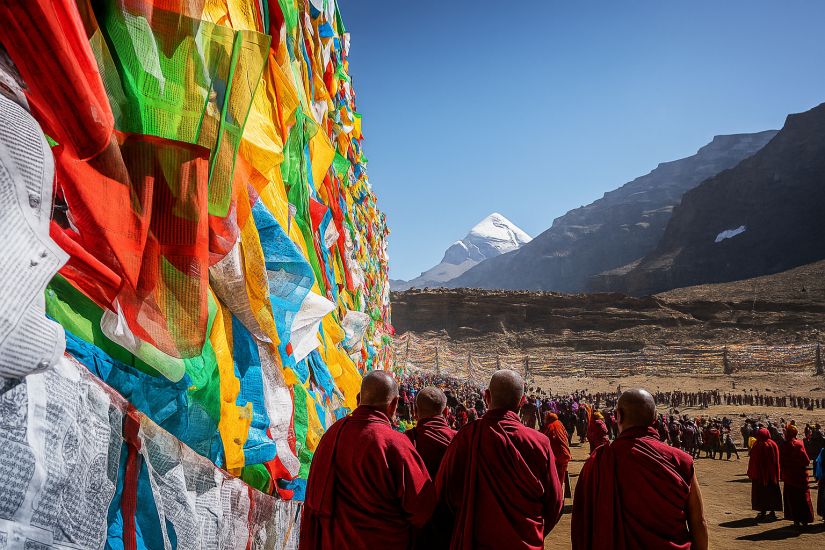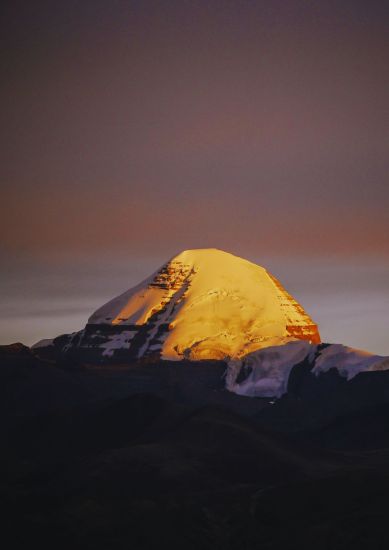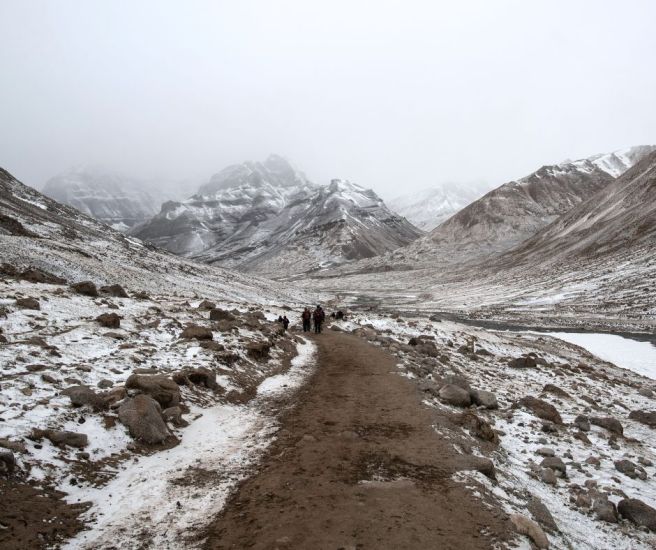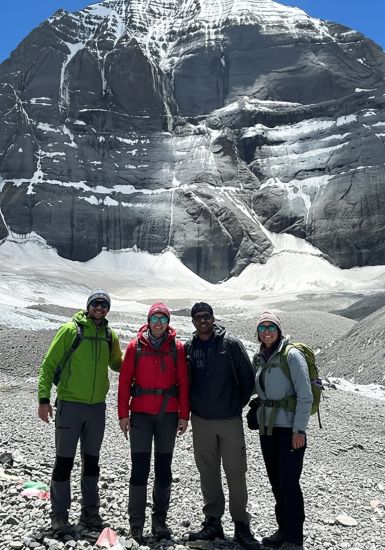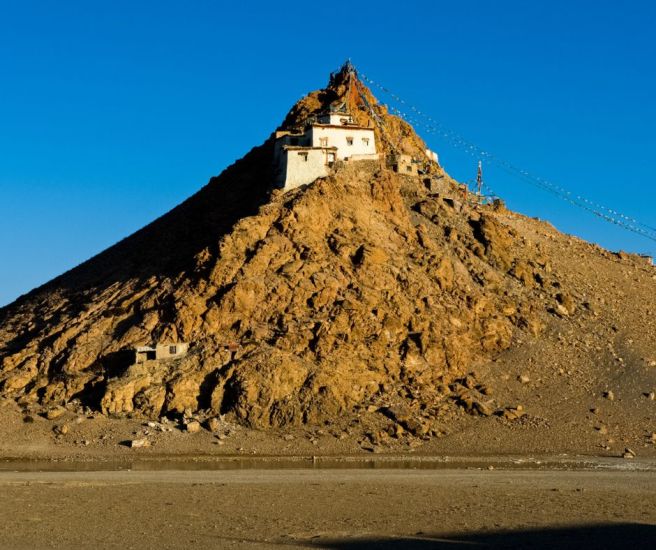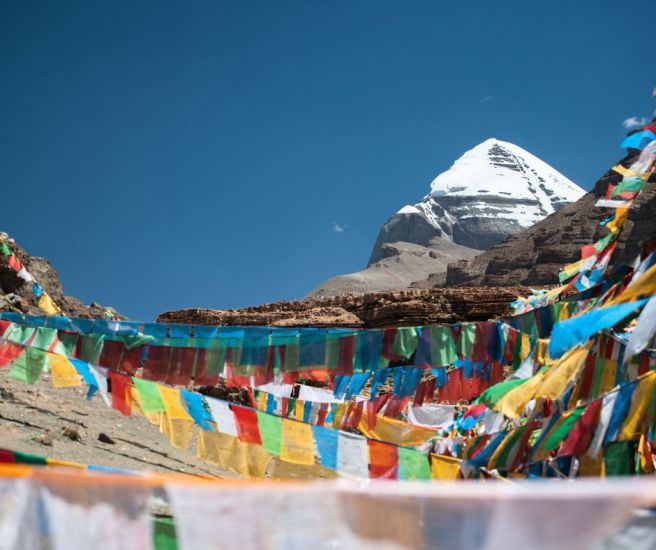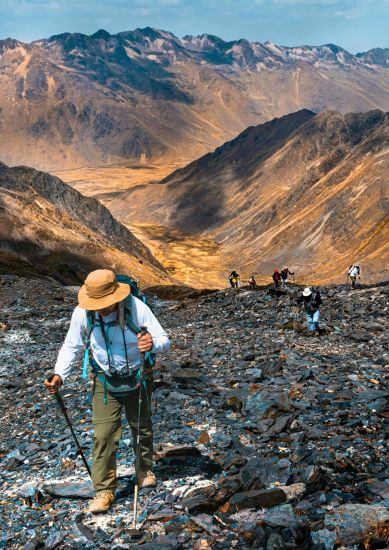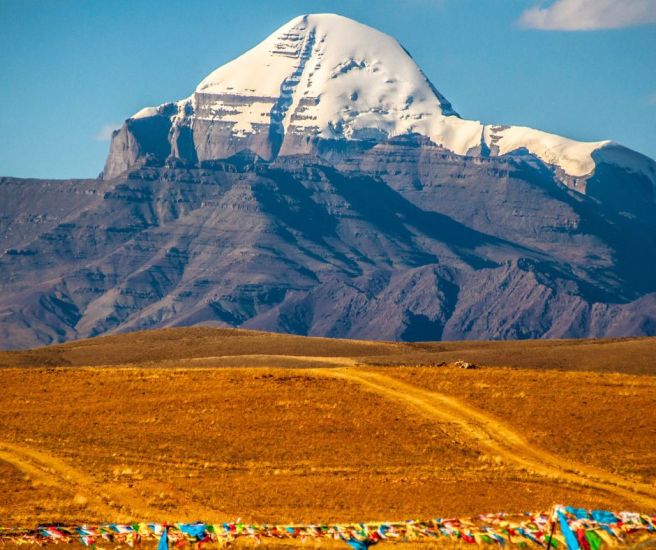Mount Kailash & Saga Dawa Festival Tour
10 Days / Tibet
Activity
Difficulty Level
Destinations
Trip Start / End
Max Altitude
Accommodation
Travel Style
Best time to travel
Personalized Travel Advice

Dev Raj Nepal
+977 9851096523
Detailed Itinerary
01
DAY
01
Take a long but scenic drive from Kathmandu to Kyirong, weaving through the mesmerizing landscapes of the Trishuli River valley. As you travel, enjoy views of the river winding below, surrounded by terraced fields, dense forests, and charming Nepali villages nestled along the hillsides. The road gradually ascends, offering glimpses of the majestic Himalayas in the distance. Arrive at Rasuwagadhi, where you’ll complete your customs and immigration procedures at the Nepal-China border. Continue your journey towards Kyirong, a peaceful Tibetan town tucked away in the rolling hills. Known for its serene atmosphere and stunning surroundings, Kyirong offers a perfect introduction to Tibet, with panoramic views of snow-capped peaks and alpine meadows. Overnight at Kyirong.
Drive from Kathmandu to Kyirong
Take a long but scenic drive from Kathmandu to Kyirong, weaving through the mesmerizing landscapes of the Trishuli River valley. As you travel, enjoy views of the river winding below, surrounded by terraced fields, dense forests, and charming Nepali villages nestled along the hillsides. The road gradually ascends, offering glimpses of the majestic Himalayas in the distance. Arrive at Rasuwagadhi, where you’ll complete your customs and immigration procedures at the Nepal-China border. Continue your journey towards Kyirong, a peaceful Tibetan town tucked away in the rolling hills. Known for its serene atmosphere and stunning surroundings, Kyirong offers a perfect introduction to Tibet, with panoramic views of snow-capped peaks and alpine meadows. Overnight at Kyirong.
02
DAY
02
After breakfast, begin your drive from Kyirong, venturing deeper into the heart of Tibet’s spectacular landscape. The road takes you through the expansive Tibetan countryside, where you’ll pass through lush green valleys, isolated monasteries, and traditional Tibetan homes. Along the way, stop to admire Pelku Lake, a pristine body of water surrounded by rugged mountains. The lake’s reflective surface mirrors the breathtaking natural beauty, offering a tranquil spot to stretch and take in the serene surroundings. Continue your journey, with several photo stops at picturesque locations until you reach Saga. Saga is a bustling town that serves as a vital waypoint for travelers heading towards Mount Kailash. Situated on the edge of the Tibetan Plateau, Saga is a lively hub, where traders and pilgrims gather. Overnight at Saga.
Kyirong – Pelku Lake – Saga
After breakfast, begin your drive from Kyirong, venturing deeper into the heart of Tibet’s spectacular landscape. The road takes you through the expansive Tibetan countryside, where you’ll pass through lush green valleys, isolated monasteries, and traditional Tibetan homes. Along the way, stop to admire Pelku Lake, a pristine body of water surrounded by rugged mountains. The lake’s reflective surface mirrors the breathtaking natural beauty, offering a tranquil spot to stretch and take in the serene surroundings. Continue your journey, with several photo stops at picturesque locations until you reach Saga. Saga is a bustling town that serves as a vital waypoint for travelers heading towards Mount Kailash. Situated on the edge of the Tibetan Plateau, Saga is a lively hub, where traders and pilgrims gather. Overnight at Saga.
03
DAY
03
Today, set off early for a scenic drive through the remote and rugged Tibetan landscapes, as you make your way towards the sacred Manasarovar Lake. The road takes you across vast open plains, dotted with small Tibetan villages and yaks grazing in the fields, offering a glimpse into the traditional rural life of Tibet.
Stop at Dzongba, a small town, where you can stretch your legs and take in the surrounding landscape. As you continue your journey, the altitude gradually rises, and the scenery becomes even more breathtaking, with sweeping views of the Tibetan Plateau and distant snow-capped peaks.
After passing through Paryang, you will finally approach the revered Manasarovar Lake, situated at an altitude of 4,590 meters. This sacred body of water, held in high esteem by both Hindus and Buddhists, is believed to be a source of purity, with its clear, turquoise waters mirroring the majestic mountains that surround it. Overnight near Mansarovar Lake.
Saga – Dzongba – Paryang – Manasarovar Lake
Today, set off early for a scenic drive through the remote and rugged Tibetan landscapes, as you make your way towards the sacred Manasarovar Lake. The road takes you across vast open plains, dotted with small Tibetan villages and yaks grazing in the fields, offering a glimpse into the traditional rural life of Tibet.
Stop at Dzongba, a small town, where you can stretch your legs and take in the surrounding landscape. As you continue your journey, the altitude gradually rises, and the scenery becomes even more breathtaking, with sweeping views of the Tibetan Plateau and distant snow-capped peaks.
After passing through Paryang, you will finally approach the revered Manasarovar Lake, situated at an altitude of 4,590 meters. This sacred body of water, held in high esteem by both Hindus and Buddhists, is believed to be a source of purity, with its clear, turquoise waters mirroring the majestic mountains that surround it. Overnight near Mansarovar Lake.
04
DAY
04
Today, visit Chiu Gompa Monastery, perched on a hill with panoramic views of Manasarovar Lake and Mount Kailash in the distance. The monastery offers a tranquil spot for reflection amidst the stunning landscape. Afterward, undertake a circumambulation around the sacred Manasarovar Lake by vehicle, a significant ritual for pilgrims seeking to purify their sins.
Once the circumambulation is complete, drive to Darchen, located at 4,575 meters. This bustling town is the starting point for the Kailash Kora trek, where you will spend the night, resting and preparing for the challenging journey around Mount Kailash.
Visit Chiu Gompa & Manasarovar Circumambulation by Vehicle. Drive to Darchen
Today, visit Chiu Gompa Monastery, perched on a hill with panoramic views of Manasarovar Lake and Mount Kailash in the distance. The monastery offers a tranquil spot for reflection amidst the stunning landscape. Afterward, undertake a circumambulation around the sacred Manasarovar Lake by vehicle, a significant ritual for pilgrims seeking to purify their sins.
Once the circumambulation is complete, drive to Darchen, located at 4,575 meters. This bustling town is the starting point for the Kailash Kora trek, where you will spend the night, resting and preparing for the challenging journey around Mount Kailash.
05
DAY
05
Today, drive from Darchen to Tarboche, located at 4,675 meters, to experience the vibrant Saga Dawa Festival. This festival is one of the most significant events in Tibetan Buddhism, commemorating the birth, enlightenment, and death of Buddha. The festival is filled with devotion, color, and spiritual energy as thousands of pilgrims gather to participate in the celebrations.
During the festival, you’ll witness traditional Tibetan rituals, including prayer ceremonies held by monks and devotees, offering prayers and performing prostrations around the holy Mount Kailash. One of the festival’s most striking highlights is the raising of the Tarboche flagpole, a symbolic event that marks the culmination of the festival. The flagpole, adorned with prayer flags, is an important focal point for the Tibetan pilgrims, who chant mantras and make offerings in reverence.
After immersing yourself in the spiritual atmosphere of the festival, return to Darchen for an overnight rest, reflecting on the cultural and religious significance of the day’s events.
Drive to Tarboche for Saga Dawa Festival – Darchen
Today, drive from Darchen to Tarboche, located at 4,675 meters, to experience the vibrant Saga Dawa Festival. This festival is one of the most significant events in Tibetan Buddhism, commemorating the birth, enlightenment, and death of Buddha. The festival is filled with devotion, color, and spiritual energy as thousands of pilgrims gather to participate in the celebrations.
During the festival, you’ll witness traditional Tibetan rituals, including prayer ceremonies held by monks and devotees, offering prayers and performing prostrations around the holy Mount Kailash. One of the festival’s most striking highlights is the raising of the Tarboche flagpole, a symbolic event that marks the culmination of the festival. The flagpole, adorned with prayer flags, is an important focal point for the Tibetan pilgrims, who chant mantras and make offerings in reverence.
After immersing yourself in the spiritual atmosphere of the festival, return to Darchen for an overnight rest, reflecting on the cultural and religious significance of the day’s events.
06
DAY
06
Today, we will take a drive to Darchen from where we start the first day of the Kailash Kora trek. The journey takes us across stunning landscapes, passing through rocky terrain and valleys, with the majestic Mount Kailash looming ahead. Our first day of trekking is relatively moderate, with an ascent towards Shiva’s Temple (Yama Dwar), the first stop of the Kora.
Along the way, you’ll pass through sacred sites where pilgrims stop to pray and reflect. These sites hold immense spiritual value, and many pilgrims walk barefoot as an expression of devotion. The route is marked by a series of stone markers, prayer flags, and sacred stones that dot the path, further enhancing the spiritual ambiance of the journey.
Throughout the day, we’ll be surrounded by the breathtaking views of Mount Kailash, which rises majestically at an altitude of 6,638 meters, and the ever-present quietude of the Tibetan Plateau. The journey is not just physical, but also a deeply spiritual one, where the tranquility of the environment and the significance of the mountain provide a unique opportunity for reflection and connection.
At the end of the day’s trek, we will rest at Dirapuk, one of the camps along the route. This serene spot offers a close-up view of Mount Kailash, allowing for further reflection before continuing the Kora the next day. The night will be spent under the vast Tibetan sky, preparing for the challenges and spiritual rewards of the next day’s trek.
Darchen – Diraphuk (Kailash Kora Day 1)
Today, we will take a drive to Darchen from where we start the first day of the Kailash Kora trek. The journey takes us across stunning landscapes, passing through rocky terrain and valleys, with the majestic Mount Kailash looming ahead. Our first day of trekking is relatively moderate, with an ascent towards Shiva’s Temple (Yama Dwar), the first stop of the Kora.
Along the way, you’ll pass through sacred sites where pilgrims stop to pray and reflect. These sites hold immense spiritual value, and many pilgrims walk barefoot as an expression of devotion. The route is marked by a series of stone markers, prayer flags, and sacred stones that dot the path, further enhancing the spiritual ambiance of the journey.
Throughout the day, we’ll be surrounded by the breathtaking views of Mount Kailash, which rises majestically at an altitude of 6,638 meters, and the ever-present quietude of the Tibetan Plateau. The journey is not just physical, but also a deeply spiritual one, where the tranquility of the environment and the significance of the mountain provide a unique opportunity for reflection and connection.
At the end of the day’s trek, we will rest at Dirapuk, one of the camps along the route. This serene spot offers a close-up view of Mount Kailash, allowing for further reflection before continuing the Kora the next day. The night will be spent under the vast Tibetan sky, preparing for the challenges and spiritual rewards of the next day’s trek.
07
DAY
07
In the morning, we continue our trek with an 18km journey from Dirapuk to Zutulpuk, a section known as the outer kora. This stretch is considered challenging, with a demanding ascent leading up to Dolma La Pass at 5,613m, the highest point of the trek. The climb is strenuous but rewarding, offering breathtaking views of the surrounding landscapes.
From Dolma La, the trail descends steeply toward Gauri Kunda, a sacred lake revered by pilgrims. Along the way, you’ll be treated to awe-inspiring vistas of Mount Kailash, adding to the spiritual and scenic allure of the trek. By late afternoon, we arrive at Zutulpuk (4,760m), where we spend the night at a guesthouse, resting for the final leg of the journey.
Diraphuk to Zutulphuk (Kailash Kora 2)
In the morning, we continue our trek with an 18km journey from Dirapuk to Zutulpuk, a section known as the outer kora. This stretch is considered challenging, with a demanding ascent leading up to Dolma La Pass at 5,613m, the highest point of the trek. The climb is strenuous but rewarding, offering breathtaking views of the surrounding landscapes.
From Dolma La, the trail descends steeply toward Gauri Kunda, a sacred lake revered by pilgrims. Along the way, you’ll be treated to awe-inspiring vistas of Mount Kailash, adding to the spiritual and scenic allure of the trek. By late afternoon, we arrive at Zutulpuk (4,760m), where we spend the night at a guesthouse, resting for the final leg of the journey.
08
DAY
08
Today marks the final leg of your Kailash Kora, completing one of the most sacred pilgrimages in the Himalayas. Begin with a gentle trek from Zutulphuk Monastery, following the trail along the valley and the serene Lha Chu River. The landscape gradually opens up, revealing the vast plains below Mount Kailash. After about 2 to 3 hours of walking, you’ll reach the Mani Wall, a long stretch of intricately carved prayer stones — each one inscribed with sacred mantras placed by countless pilgrims over centuries.
From here, you rejoin your vehicle for the drive back to Darchen, marking the end of the holy circumambulation around Mount Kailash. Take a moment to reflect on this profound spiritual journey before continuing the drive across the rugged Tibetan plateau to Paryang. Along the way, enjoy sweeping views of remote valleys and mountain horizons that seem to stretch endlessly into the sky. Overnight in Paryang.
Zutulphuk – Mani Wall – Darchen – Paryang (Kailash Kora 3)
Today marks the final leg of your Kailash Kora, completing one of the most sacred pilgrimages in the Himalayas. Begin with a gentle trek from Zutulphuk Monastery, following the trail along the valley and the serene Lha Chu River. The landscape gradually opens up, revealing the vast plains below Mount Kailash. After about 2 to 3 hours of walking, you’ll reach the Mani Wall, a long stretch of intricately carved prayer stones — each one inscribed with sacred mantras placed by countless pilgrims over centuries.
From here, you rejoin your vehicle for the drive back to Darchen, marking the end of the holy circumambulation around Mount Kailash. Take a moment to reflect on this profound spiritual journey before continuing the drive across the rugged Tibetan plateau to Paryang. Along the way, enjoy sweeping views of remote valleys and mountain horizons that seem to stretch endlessly into the sky. Overnight in Paryang.
09
DAY
09
Drive through the scenic Tibetan landscape, passing valleys, rivers, and Tibetan villages on the way back to Kyirong, a charming town known for its mild climate and lush greenery.
Paryang – Saga – Kyirong
Drive through the scenic Tibetan landscape, passing valleys, rivers, and Tibetan villages on the way back to Kyirong, a charming town known for its mild climate and lush greenery.
10
DAY
10
Cross the border at Rasuwagadhi and continue your drive back to Kathmandu. The route offers stunning views of the lush green hills, rivers, and local villages. Upon arrival, transfer to your hotel or explore the vibrant city of Kathmandu, rich in cultural heritage and historical landmarks.
Kyirong – Kathmandu
Cross the border at Rasuwagadhi and continue your drive back to Kathmandu. The route offers stunning views of the lush green hills, rivers, and local villages. Upon arrival, transfer to your hotel or explore the vibrant city of Kathmandu, rich in cultural heritage and historical landmarks.
Includes / Excludes
Inclusions
-
Hotel, Guest House or Tented Accommodation as per program.
-
Private Transportation as per the group size.
-
All necessary Tibet Travel and Trekking permit.
-
One English speaking Tibetan Guide.
-
All Sightseeing and Entrance fee.
-
Tibet Group Visa
-
Meal mentioned in the itinerary
Exclusions
-
Travel and personal Expenses.
-
Sleeping bags and Mattress for the tent stay.
-
Insurance of any kind & Medical fee if Emergency.
-
Hiring porter/ horse.
-
Portable oxygen cylinders in of emergency.
-
Rescue and Evacuation Service
-
Any Additional cost due to Nature calamity and Unforeseen Circumstances and etc.
Trip Info
The Saga Dawa Festival in 2026 will be celebrated on 31 May, coinciding with the full moon of the fourth month in the Tibetan lunar calendar. This sacred festival honors three pivotal events in the life of Lord Buddha: his birth, enlightenment, and passing into nirvana. During this deeply spiritual time, pilgrims and devotees gather at holy sites across Tibet, to perform prayers.
Saga Dawa Festival
Saga Dawa Festival usually falls in the months of May or June. It is observed on the 15th day of the 4th month of the Tibetan lunar calendar, which typically aligns with late May or early June in the Gregorian calendar.
Saga Dawa Festival is one of the most significant events in Tibetan Buddhism, celebrated with great devotion and enthusiasm at Tarboche near Mount Kailash. The festival marks the birth, enlightenment, and death of the Buddha, known as the “Buddha’s Day.”
During this vibrant occasion, thousands of pilgrims gather to participate in traditional Tibetan rituals, including prayer ceremonies, prostrations, and offerings around Mount Kailash.
One of the highlights of the festival is the raising of the Tarboche flagpole, adorned with colorful prayer flags, which symbolizes the culmination of the spiritual event. The air is filled with reverence, as pilgrims chant mantras and seek blessings, making it a deeply spiritual experience for all who attend.
May and June are among the best months to visit Tibet, offering pleasant temperatures and clear skies ideal for sightseeing and trekking. During these months, daytime temperatures generally range from 15°C to 22°C (59°F–72°F) in lower areas such as Lhasa, while higher-altitude regions like the Kailash region remain cooler, often between 5°C and 12°C (41°F–54°F). Nights can still be chilly, especially in the mountains, so layering is recommended.
The skies are typically clear and sunny, providing excellent visibility of snow-capped peaks, sacred monasteries, and the vast Tibetan plateau. Rainfall is relatively low, though occasional light showers may occur in late June as the monsoon season approaches. Overall, this period is ideal for pilgrims, trekkers, and travelers to attend Saga Dawa Festival and do the Kailash Kora Trek.
Private Vehicles
Throughout the trip, private vehicles will be used for transfers and sightseeing. These include comfortable cars or SUVs, which are good for navigating both urban and rural areas. These vehicles are chosen for their comfort and reliability, ensuring a smooth and enjoyable journey between destinations. They are equipped to handle various road conditions and provide a high level of convenience for travelers.
Minivans or Buses
For group travel of more than 8 people Buses will be used and for a smaller group of people, Minivans can be used. These vehicles are suitable for accommodating larger groups and offer ample space for passengers and luggage. Equipped with air conditioning and comfortable seating, these vehicles are designed to enhance travel comfort over longer distances. They also offer better stability and space for scenic drives and excursions.
Accommodation during this Tibet tour can range from hotels to basic guesthouses to simple lodges, offering a modest yet comfortable stay. Most of the accommodations are located in Tibetan towns and villages along the route, such as Saga, Paryang, and Darchen, where you will be provided with local guesthouses or dormitory-style rooms. These places typically offer basic amenities, including beds, shared bathrooms, and simple heating (usually a stove or electric heater).
Near Manasarovar Lake and Kailash, accommodation options are more limited and often basic, with a focus on providing travelers with a place to rest during their spiritual journey. Some areas might offer basic dormitories, while others might have tents or simple rooms in guesthouses, depending on the season and availability. The facilities may not always include hot water or electricity, and the atmosphere is often rustic, emphasizing a connection with the natural surroundings.
While the accommodations are modest, they provide a comfortable environment for rest after long drives and treks, offering an opportunity to immerse in the serene and spiritual ambiance of the region.
Food during the Mount Kailash pilgrimage and Tibet trip is simple and hearty, reflecting local Tibetan cuisine designed to sustain travelers on their physically demanding journey. In towns like Saga, Darchen, and Paryang, meals typically include rice, noodles, vegetables, and Tibetan bread (thukpa or tsampa) with butter tea. In more remote areas near Manasarovar Lake or during the Kailash Kora trek, options are basic, with instant noodles, rice porridge, and limited meat (yak or mutton).
Western food is rare, especially in remote locations. In larger towns, you may find basic dishes like pasta, fried eggs, and sandwiches, but they are adapted to local ingredients. It’s a good idea to bring snacks like energy bars and instant coffee to supplement meals. For travelers with dietary preferences or restrictions, it’s advised to inform the tour operator in advance, as vegetarian and vegan options are more common in towns but limited in remote areas.
Tibet (China)
To travel to Tibet, all foreign nationals must first obtain a Chinese Tourist Visa (L visa) from a Chinese Embassy or Consulate in their home country. This should be arranged at least one month before your trip. Once you have your Chinese visa, we will apply for your Tibet Travel Permit on your behalf. This permit is essential and will be checked when boarding your flight or train to Lhasa and again upon arrival. The Tibet Travel Permit is issued by the Tibet Tourism Bureau and typically takes 10–15 working days to process after receiving your Chinese visa copy. Individual application is not accepted by the Bureau.
For more information, Visit Visa for China
Nepal
Nepal offers a visa-on-arrival facility for citizens of most countries. You can obtain your visa at Tribhuvan International Airport in Kathmandu or at certain land border crossings. The process is quick and straightforward. Just bring a valid passport (minimum 6 months validity), pay a visa fee in USD or other major currencies. Visa durations of 15, 30, or 90 days are available depending on the length of your stay.
For more information visit Nepal Immigration
Scenic Landscapes and Spiritual Vibes
Embarking on this Tibet Festival Tour is an extraordinary journey that will captivate your senses with stunning landscapes, spiritual significance, and rich cultural experiences. As you make your way through the vast Tibetan plateau, you’ll be surrounded by towering snow-capped peaks, serene lakes like Manasarovar, and expansive valleys that stretch endlessly before you. The natural beauty of this region is unlike any other, offering unparalleled opportunities for reflection and awe as you journey to one of the most sacred destinations in the world.
Rugged Terrain and High Altitudes
The trip will take you to high altitudes, with Mount Kailash itself towering above the surrounding terrain. As you venture into these elevated regions, expect the environment to be both rugged and breathtaking, with remote villages, ancient monasteries, and quiet pilgrimage routes adding to the mystique of the area. This is a journey of both physical challenge and spiritual awakening, and the awe-inspiring views of the Himalayas and Tibetan plateau will stay with you long after your trip ends.
Cultural and Spiritual Immersion
On this Tibet Festival Tour, you’ll get a deep dive into Tibetan culture, meeting local villagers and pilgrims who make this journey for religious reasons. The people you encounter will share stories, prayers, and insights about the area’s spiritual significance, enriching your understanding of the land and its traditions. Visits to monasteries and sacred sites will offer moments of quiet reflection and connection to a centuries-old spiritual heritage.
Basic but Nourishing Food
Food during your Tibet Festival Tour will be simple but nourishing, designed to fuel you for the physically demanding journey. The local Tibetan cuisine is hearty, with dishes centered around rice, noodles, vegetables, and Tibetan bread. While more remote areas may offer limited food options, towns like Saga, Darchen, and Kyirong will have restaurants that provide some international flavors, though with a local twist. Be prepared for a cultural culinary experience, and consider bringing along some snacks to supplement meals, especially as you travel deeper into Tibet.
Limited Western Comforts
Expect to be away from the usual comforts of home, as this is a remote, high-altitude journey. While larger towns may offer limited Western-style food and accommodations, they will still be simple and reflect local customs. In more remote areas, comforts such as Western food or familiar luxuries will be scarce. This is a trip where embracing the local culture and lifestyle will enhance the experience, and you’ll find that simplicity and tranquility are the true highlights.
Physical Challenges and Rewards
The Mount Kailash trek, including the sacred Kora around the mountain, is physically demanding. The terrain can be rugged and the altitude high, which may make some travelers feel breathless or fatigued. However, the reward is immense. The stunning views, the sense of achievement, and the deep spiritual connection you’ll experience as you walk in the footsteps of pilgrims who have come here for centuries make the effort worthwhile. Whether you’re trekking around Mount Kailash, visiting sacred lakes, or taking in the high-altitude air, the sense of accomplishment and peace will stay with you long after the journey ends.
Warm Hospitality in Remote Areas
Although the infrastructure may be basic, the warmth and hospitality of the local Tibetan people will be a highlight of your Tibet Festival Tour. Guesthouses and accommodations may be simple, but the kindness of the staff and fellow travelers will make you feel welcome. The communal atmosphere in these places fosters a sense of camaraderie, especially as you meet other pilgrims and travelers on a similar journey.
FAQs
Personalized Travel Advice

Dev Raj Nepal
+977 9851096523
